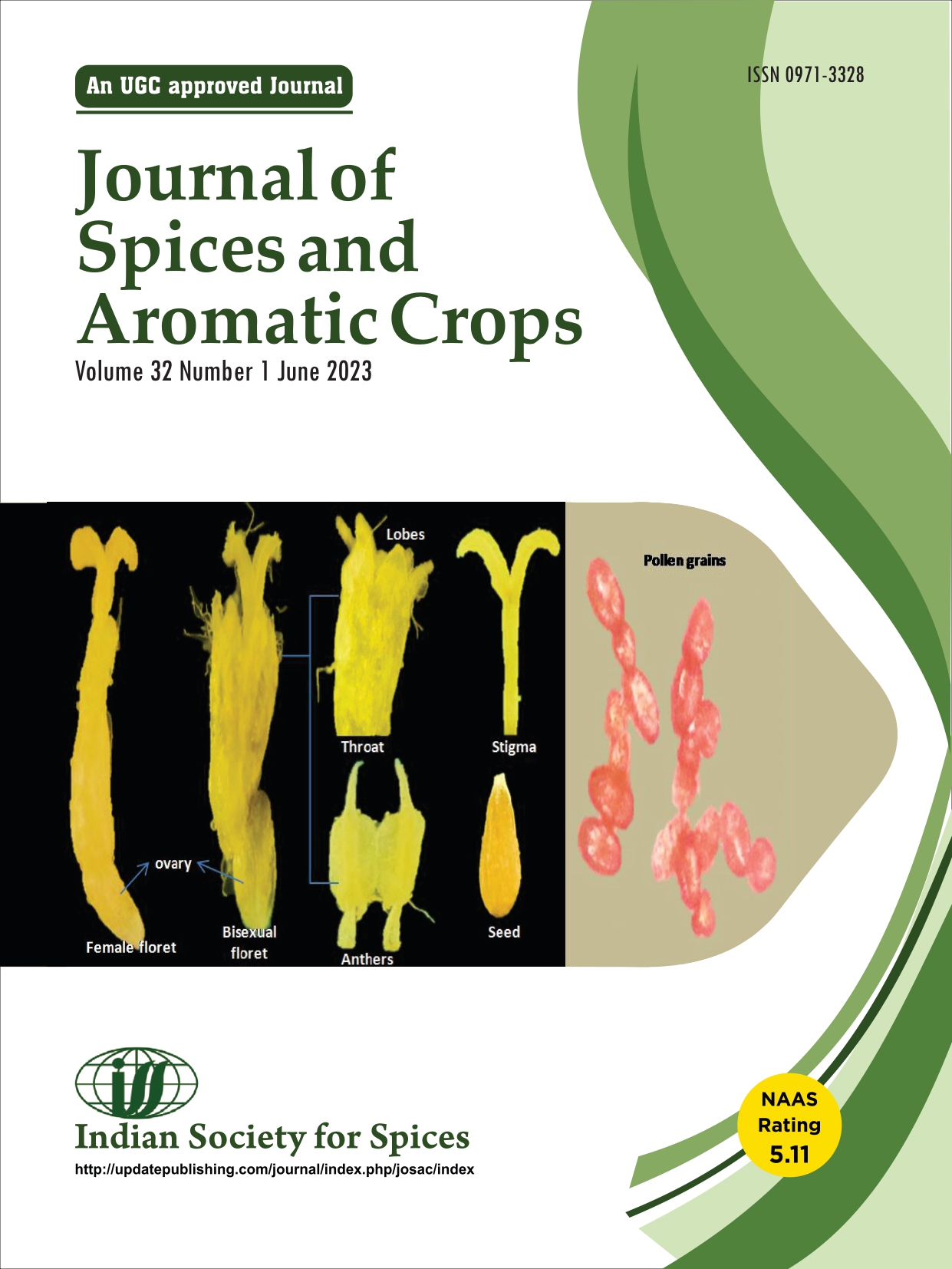Quantitative and qualitative evaluation of saffron (Crocus sativus L.) for genetic variability, character association and path analysis
Genetic variability, character association and path analysis in saffron
DOI:
https://doi.org/10.25081/josac.2023.v32.i1.8192Keywords:
Saffron, coefficient of variation, correlation, genetic diversity, heritability, path analysisAbstract
Different accessions of saffron were studied to analyze genetic diversity and heritable component of variation in yield and yield related traits. Dry pistil weight, fresh pistil weight, fresh flower weight corm-1 line-1, number of flowers corm-1 line-1, and big corm index, all had high genotypic coefficient of variation, heritability and genetic advance. The traits included in the selection scheme, correlation among traits (floral and agronomic) are important as varieties must have high yield associated with exemplary quality parameters. At both phenotypic and genotypic levels, the association was found significant among the traits. Stigma length and fresh flower weight had strong direct effect with respect to dry pistil weight followed by number of flowers corm-1 line-1, fresh pistil weight and big corm index. Therefore, these parameters can be taken as criteria for selection.
Downloads
References
Al-Jibouri H A, Miller P A & Robinson H F 1958 Genetic and environmental variances and co-variances in an upland cotton cross of interspecific origin. J. Agron. 50: 633–636.
Bekavac G, Purar B & Jockovic D 2008 Relationships between line per se and testcross performance for agronomic traits in two broad-based populations of maize. Euphytica. 162: 363–369.
Bekavac G, Purar B, Stojakovic M, Jockovic D, Ivanovic M & Nastasic A 2007 Genetic analysis of stay-green trait inbroad-based maize populations. Cereal Res. Commun. 35: 31–41.
Burton G W 1952 Quantitative inheritance of grasses. In: Proceedings 6th International Grassland Congress. 1: 273–283.
Dewey J R, Lu K H 1959 A correlation and path coefficient analysis of components of crested wheat seed production. J. Agron. 51:515–518.
Fernández J A 2004 Biology Biotechnology and Biomedicine of Saffron. Rec. Res. Develop. Pl. Sci. 2: 127–159.
Gresta F, Avola G, Lombardo G, Siracusa L, Ruberto G 2009 Analysis of flowering, stigmas yield and qualitative traits of saffron (Crocus sativus L.) as affected by environmental conditions. Sci. Hort. 119: 320–324
Johnson H W, Robinson H F, Comstack R 1955 Estimates of genetic and environmental variability. J. Agron. 47:14–18.
Lush J L 1949 Heritability of quantitative characters in farm animals. Herbicides. 35: 356–357.
Mahdi B, Mehdi R & Mehdi R 2016 Determining the most effective traits to improve saffron (Crocus sativus L.) yield. Physiol. Mol. Biol. Plants. 22(1): 153–161.
Nehvi F A & Salwee Y 2010 Saffron Farming in India, the Kashmir Connection. Financing Agriculture. 42: 9–15.
Plessner O, Negbi M, Ziv M & Baske D 1989 Effect of temperature on flowering of saffron (Crocus sativus L.): induction of hysteranthy. Isr. J. Plant Sci. 38: 1–7.
Sheikh F A, Makhdoomi M I, Nehvi F A, Ajaz A L, Gowhar Ali & Bhat M A 2014 Cause and effect relationship to identify important yield contributing traits in saffron (Crocus sativus L.). Hort Flora Res Spec. 3: 244–248.
Singh R K. & Chaudhary B D 1985 Biometrical methods in quantitative genetic analysis. Kalyani Publishers, Ludhiana, New Delhi, pp 54–57.
Sivasubramanian S & Madhava M P 1973 Genotypic and phenotypic variability in rice. Madras Agric J. 60: 1093–1096.
Verma P R, Yikbarek S M and Morrall R A 1987 Anastomosis groups, Pathogenicity and Specificity of Rhizoctonia solani isolates from seedling and adult rapeseed/canola plants and soils in Saskatchewan. J. Plant Pathol. 9: 6–13.
Published
How to Cite
Issue
Section
Copyright (c) 2023 Mohammad Irfan, Uzma Rahid, Sabeena Nasseer, M Ashraf Bhat, Z A Dar, M Altaf Wani, Shahid Rasool, M H Khan, Rayees A Wani

This work is licensed under a Creative Commons Attribution-NonCommercial-NoDerivatives 4.0 International License.






 .
.